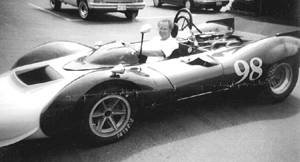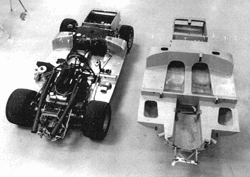| Shelby Can-Am Cars
by Duane Carling |
The 1967 Shelby Cobra Can-Am cars are a little known piece of Shelby history. Byron Sanborn of Vintage Racing Motors in Redmond, Washington has been preparing the #2 Can-Am chassis with good success, driven by Jim Giese. VRM has given it the development it deserved and never got from Shelby. At the end of a recent Sears Point race, John Cannon, former crew chief for Shelby shook Byron’s hand and said “Congratulations, you guys put more miles on that car today than we did the whole year we had it at Shelby’s.” Shelby, Len Terry and Dan Gurney formed a partnership in 1967, named Trans Atlantic Consultants to build Indy Cars, F-l cars and Can-Am cars using as many parts in common as possible. Three Can-Am cars were built to a Len Terry design, that turned out to be the right car at the wrong time. In Can-Am racing the era of down force, big blocks and mega horse power was just starting. Terry had designed his car around small blocks (a Ford Indy V-8 was to have been fitted eventually) slip through the air body shapes, and keeping everything as lightweight as possible.  Chassis #1 arrived at Shelby’s shop just days before it was to
run in the 1967 Times GP. Fitted with a 350 HP Westlake Ford 289, the
first time it rolled off the trailer a suspension pick-up sheared off and
came through the aluminum body. After much midnight oil, the car was
entered with Jerry Titus as the driver, where the fuel pump failed after
just 3 laps. Shelby realized he had an obsolete car on his hands, and did
no further development. He raced the car once more at the season-ending
Star Dust GP in Las Vegas, where it crashed. All the usable parts were
transferred to chassis #2, and it was sold along with #3 to a privateer. Chassis #1 arrived at Shelby’s shop just days before it was to
run in the 1967 Times GP. Fitted with a 350 HP Westlake Ford 289, the
first time it rolled off the trailer a suspension pick-up sheared off and
came through the aluminum body. After much midnight oil, the car was
entered with Jerry Titus as the driver, where the fuel pump failed after
just 3 laps. Shelby realized he had an obsolete car on his hands, and did
no further development. He raced the car once more at the season-ending
Star Dust GP in Las Vegas, where it crashed. All the usable parts were
transferred to chassis #2, and it was sold along with #3 to a privateer.
T  he car was club raced for a couple of years with a Chevy
engine, when it was sold again and disappeared. It eventually made its way
to VRM through a bank sale, where it was disassembled and rebuilt to
modern standards. First on the agenda was to strengthen the suspension and
rear portion of the tub to accept a 600 HP Ford 351 Cleveland motor. “That
really woke up the car”, said Byron who did much of the work. “That, and
figuring out the ‘Marquis de Sade’ suspension so it would stay on the
track.” Terry wanted to separate the centrifugal cornering forces from the
bump forces, so he used single transverse coil springs front and rear to
suspend the car. If you pick up the chassis, the suspension will move up
and down freely like a teeter totter. Remaking the suspension arms with
higher grade and heavier material, and taking advantage of modern tires,
owner Jim Geise screams around his Seattle Raceway home track with good
success and complete confidence. he car was club raced for a couple of years with a Chevy
engine, when it was sold again and disappeared. It eventually made its way
to VRM through a bank sale, where it was disassembled and rebuilt to
modern standards. First on the agenda was to strengthen the suspension and
rear portion of the tub to accept a 600 HP Ford 351 Cleveland motor. “That
really woke up the car”, said Byron who did much of the work. “That, and
figuring out the ‘Marquis de Sade’ suspension so it would stay on the
track.” Terry wanted to separate the centrifugal cornering forces from the
bump forces, so he used single transverse coil springs front and rear to
suspend the car. If you pick up the chassis, the suspension will move up
and down freely like a teeter totter. Remaking the suspension arms with
higher grade and heavier material, and taking advantage of modern tires,
owner Jim Geise screams around his Seattle Raceway home track with good
success and complete confidence. I am the proud owner of chassis #3, which spent over 20 years leaning up against a one car garage in Los Angeles before I found it. I took it to VMR to see what it would take to complete it as the race car it was intended to be. Setting next to #2 was like a home coming. “It’s not very often we see a vintage chassis that has never had a bolt on it,” said Byron. “In fact I can’t remember ever seeing one in all the years I’ve been in this business.” Looking at the original next to the chassis that has been modified over the years, not much has really changed. More leg room has been added under the dash, air flow to the front radiator has been improved, and it’s obvious the suspension and engine mounts have been strengthened. The cars are twin sisters, that never got to go to the big dance. It will take about $100,000 in today’s money to make chassis #3 a complete car. Chassis #2 is worth about $ l20 to $130K. That makes the bare chassis worth about $20 to $30K as it sits. Maybe the market for vintage cars will come back to 1980’s levels, and make the project a heck of a good investment. VRM has advised me that, # 1; unless I have $100K sitting around (I don’t) or, #2; just want to do it for sentimental reasons (I would like to, but see #1), to sell the chassis to someone who would like to do the project and finish it exactly the way they want it. That sounds like good advice. Vintage racing seems to be equal parts nostalgia, fun, and finances. It’s important to not let the pieces get out of balance. The Cobra Can-Am chassis #3 is the real thing, and is listed in the Shelby American Auto Club (SAAC) registry. It’s currently looking for a new home with an enthusiast who will complete it and take it vintage racing. That is unless I win the lottery first! The Cobra Can-Am is a piece of Shelby history, and a tribute to the old snake hisself. He could see his hand would never beat a full house, and know’d when to fold ‘em. Duane Carling 617 West 1900 North Farmington, Utah 84025 801/451-5283 Pricing information for restoration of the Shelby CanAm
Home - About us - Mustang Services - Cobra CanAm - Contact Us - Links |